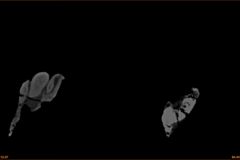Project 3122: A. J. Moore, J. Mo, J. M. Clark, X. Xu. 2018. Cranial anatomy of Bellusaurus sui (Dinosauria: Eusauropoda) from the Middle-Late Jurassic Shishugou Formation of northwest China and a review of sauropod cranial ontogeny. PeerJ. 6:e4881.
Abstract
Bellusaurus sui is an enigmatic sauropod dinosaur from the Middle-Late Jurassic Shishugou Formation of northwest China. Bellusaurus is known from a monospecific bonebed preserving elements from more than a dozen juvenile individuals, including numerous bones of the skull, providing rare insight into the cranial anatomy of juvenile sauropods. Here, we present a comprehensive description of the cranial anatomy of Bellusaurus, supplementing the holotypic cranial material with additional elements recovered from recent joint Sino-American field expeditions. Bellusaurus is diagnosed by several unique autapomorphies, including a neurovascular foramen piercing the ascending process of the maxilla at midheight, the frontal process of the nasal extending farther posteriorly onto the frontal than the prefrontal, and U-shaped medial and lateral notches in the posterior margin of the ventral process of the squamosal. Several features identified here, including a preantorbital opening in the maxilla, a stepped dorsal margin of the vomerine process of the pterygoid, and the partitioning of the dorsal midline endocranial fossae associated with the dural venous sinuses into anterior and posterior components by a transverse ridge of the parietal, are consistent with recent phylogenetic hypotheses that recover Bellusaurus as a basal macronarian or close relative of Neosauropoda. We review the current state of knowledge of sauropod cranial ontogeny, placing several aspects of the cranial anatomy of Bellusaurus in an ontogenetic context and providing explicit hypotheses of ontogenetic transformations that can be tested by future discoveries of ontogenetic variants of sauropod skulls. While scoring ontogenetically variable characters as unknown may help to alleviate the biasing effects of ontogeny on the phylogenetic position of juvenile specimens, we caution that this approach may remove phylogenetically informative character information, and argue that inference methods that are known to be less sensitive to homoplasy than equal weights parsimony (i.e., implied weights parsimony; Bayesian approaches) should also be employed.Read the article »
Article DOI: 10.7717/peerj.4881
Project DOI: 10.7934/P3122, http://dx.doi.org/10.7934/P3122
| This project contains |
|---|
Download Project SDD File |
Currently Viewing:
MorphoBank Project 3122
MorphoBank Project 3122
- Creation Date:
27 February 2018 - Publication Date:
12 May 2018 - Media downloads: 15

This research
supported by
Authors' Institutions ![]()
- The George Washington University
- Institute of Vertebrate Paleontology and Paleoanthropology (IVPP), CAS
- Natural History Museum of Guangxi Zhuang Autonomous Region
Members
| member name | taxa |
specimens |
media |
| Andrew Moore Project Administrator | 1 | 2 | 2 |
Project has no matrices defined.
Project downloads 
| type | number of downloads | Individual items downloaded (where applicable) |
| Total downloads from project | 190 | |
| Project downloads | 175 | |
| Media downloads | 15 | M480152 (10 downloads); M480153 (5 downloads); |

